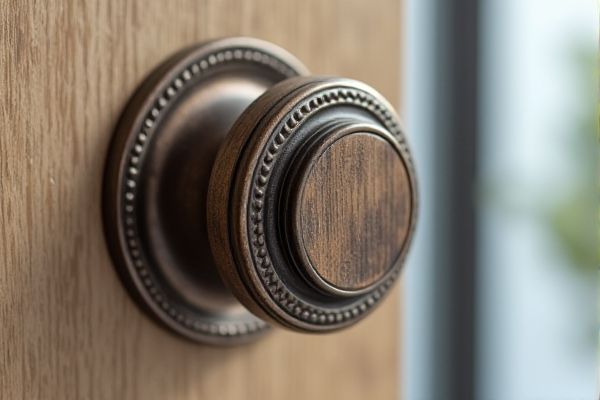
Metal hardware offers superior strength and durability, making it ideal for heavy-duty applications, while ceramic hardware provides excellent resistance to heat and corrosion with a lightweight design. Explore the full article to discover which option best suits your specific needs and projects.
Table of Comparison
| Feature | Metal Hardware | Ceramic Hardware |
|---|---|---|
| Durability | High, resistant to impact and wear | Moderate, prone to chipping |
| Weight | Heavier | Lighter |
| Corrosion Resistance | Varies by metal type; stainless steel resists corrosion | Excellent, non-corrosive |
| Cost | Generally lower | Higher due to manufacturing process |
| Strength | High tensile strength | Brittle but strong under compression |
| Applications | Construction, automotive, electronics | Medical implants, high-heat environments |
| Maintenance | Requires occasional anti-corrosion treatment | Low maintenance |
Introduction to Metal vs Ceramic Hardware
Metal hardware offers superior strength and durability, making it ideal for heavy-duty applications and structural components. Ceramic hardware excels in heat resistance and electrical insulation, often used in high-temperature environments and electronic devices. Understanding the difference between metal and ceramic hardware helps you select the best material for your specific technical needs.
Material Composition and Properties
Metal hardware primarily consists of iron, steel, aluminum, or brass, offering high tensile strength, durability, and excellent thermal conductivity. Ceramic hardware, made from silicon carbide, alumina, or zirconia, provides superior hardness, resistance to corrosion, and excellent electrical insulation properties. Your choice between metal and ceramic hardware depends on the specific requirements for strength, heat resistance, and electrical insulation in your application.
Durability and Longevity Comparison
Metal hardware offers superior durability and longevity due to its resistance to wear, impact, and corrosion, making it ideal for high-use applications. Ceramic hardware, while harder and more scratch-resistant, can be more brittle and prone to chipping under heavy stress, limiting its lifespan in demanding environments. Choosing metal ensures your installations withstand long-term use, whereas ceramic suits decorative applications where aesthetics and scratch resistance are prioritized.
Aesthetic Appeal and Design Versatility
Metal hardware offers a sleek, modern aesthetic with a polished finish that complements contemporary and industrial design styles, enhancing the overall visual appeal of your space. Ceramic hardware provides a warm, handcrafted look with a variety of colors and patterns, allowing for greater design versatility in traditional, rustic, or eclectic interiors. Choosing between metal and ceramic hardware depends on your desired aesthetic, with metal emphasizing durability and minimalist elegance, while ceramic highlights artistic detail and customization.
Performance in High-Stress Applications
Metal hardware offers superior strength and durability in high-stress applications, providing reliable performance under extreme loads and harsh environmental conditions. Ceramic hardware excels in resistance to corrosion, electrical insulation, and lightweight properties but may lack the toughness required for heavy mechanical stress. Your choice depends on balancing mechanical strength with factors like weight and conductivity for optimal performance.
Corrosion and Wear Resistance
Metal hardware, especially stainless steel and titanium alloys, offers excellent wear resistance but can be susceptible to corrosion in harsh environments unless properly treated or coated. Ceramic hardware exhibits superior corrosion resistance due to its inert nature and also demonstrates exceptional wear resistance thanks to its high hardness and low friction properties. Choosing between metal and ceramic hardware depends largely on the application's exposure to corrosive elements and mechanical stress requirements.
Installation and Maintenance Requirements
Metal hardware generally offers easier installation due to its flexibility and the availability of standard fasteners, while ceramic hardware often requires precise handling and specialized tools to avoid damage during installation. Maintenance for metal hardware involves routine checks for rust or corrosion, especially in outdoor or humid environments, whereas ceramic hardware is more resistant to wear but may need careful cleaning to prevent surface scratches or chips. Your choice should consider the ease of installation and long-term upkeep to ensure both durability and performance.
Cost Analysis: Metal vs Ceramic
Metal hardware typically offers a lower upfront cost compared to ceramic, making it a budget-friendly option for many projects. Ceramic hardware, while more expensive initially, provides superior durability and resistance to corrosion, potentially reducing long-term maintenance expenses. Your choice between metal and ceramic should weigh immediate budget constraints against the value of extended lifespan and performance benefits.
Environmental Impact and Sustainability
Metal hardware often has a higher environmental impact due to energy-intensive mining and smelting processes that release significant greenhouse gases, while ceramic hardware benefits from using abundant natural materials and lower emissions during production. Ceramic components typically offer better sustainability through their durability and inert properties, reducing the need for frequent replacement and minimizing waste. Choosing ceramic hardware can support your efforts toward eco-friendly construction by decreasing environmental degradation and promoting resource conservation.
Choosing the Right Hardware for Your Needs
Metal hardware offers superior durability and strength, making it ideal for heavy-duty applications and high-traffic areas. Ceramic hardware provides a stylish aesthetic and is resistant to corrosion and heat, suitable for decorative or light-use scenarios. Assess your specific needs based on usage, environment, and design preferences to choose the right hardware for your project.
 homyna.com
homyna.com